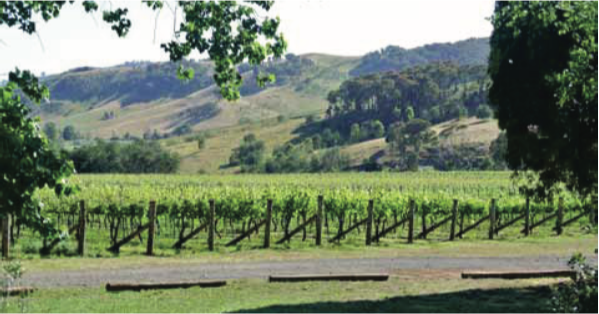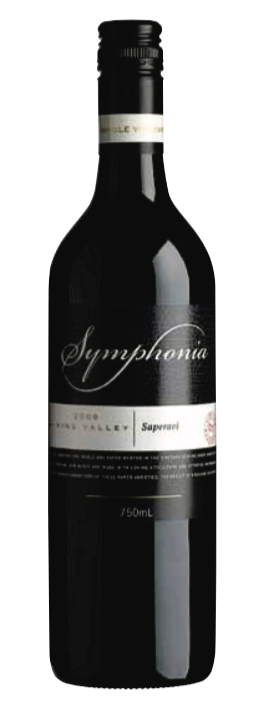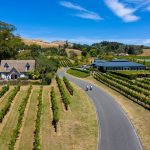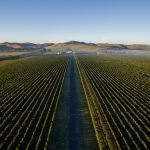By Lilian Carter, Winemaker, Symphonia Wines, King Valley, Victoria
First published in the September/October 2014 issue of the Wine & Viticulture Journal

 Background
Background
Symphonia Wines’ founder Peter Read became interested in Saperavi around 1994 when the variety showed up very favourably in wine trials conducted over a few years by Brown Brothers.
In the early 1990s, most growers and winemakers were focusing only on the so-called classic varieties. These varieties came from areas in France and Portugal where the British had a strong trading relationship. There was practically no interest in what we now know as alternative varieties from other European regions.
At the time, Read felt there would be varieties from these countries that would suit the King Valley. He subsequently set about exploring those regions that appeared to have climates similar to that of the King Valley. He visited most of the climatically similar areas of Western Europe, but unfortunately was unable to visit the equivalent Eastern European regions. However, his desk work suggested that the Kakheti region of Georgia was climatically similar to the growing season in the King Valley.
As the best Saperavi wine came from this part of Georgia, Read added it to his wish list. It is also worth noting Saperavi is the most widely planted red variety in the former USSR countries where it has a number of uses. Peter Read sourced the Saperavi planting material for his Symphonia vineyard at Myrree from Mark Walpole’s Whorouly vineyard in north-east Victoria, from where Brown Brothers had largely sourced the grapes for its trials. Saperavi was one of some 60 varieties Walpole had established during 1989 and 1990 as part of his ‘variety collection’. He recalls using Jancis Robinson’s book ‘Vines, Grapes and Wines’ as his guide on what to plant, noting the varieties she said were high quality or had quality potential and may work in his area. He subsequently sourced his cutting material from the CSIRO.
“On my place where the Saperavi vines are on own roots, it is a pathetic vine with extremely low vigour and short shoots if not pruned heavily. The act of grafting seems to invigorate it in every circumstance,” Walpole notes.
The viticulture
The Symphonia vineyard, now owned by Peter and Suzanne Evans, has a warm temperate climate of 1500 to 1600 degree days with the hillside vineyard performing best. The majority of the Saperavi vines were top grafted from Cabernet Sauvignon on Schwarzmann rootstock nearly 20 years ago in 1995.
The vines are on well-drained red duplex soil which can lead to vigorous canopies in wetter seasons, and large bunches, particularly on spur-pruned vines. This has necessitated both bunch thinning and bunch reduction in those wetter seasons. Although individual bunches can be large, they are always very loose, and reducing the size of the larger bunches is relatively easy.
We have found that arched cane canopies with eight-bud canes yield the best results. The canopies are then quite open, well exposed, easy to work on, and minimise disease. With their red flesh and thick skins, berries will yield the best wine from the light exposed grapes. We understand this is also best practice in Georgia.
The leaves of the Saperavi vines have a very furry back, and this can be an ideal home for mites, particularly rust mites.
Consequently, running a spray program to minimise rust mite populations in the vineyard is essential.
The vines have shown evidence of virus infections in some seasons. We would strongly recommend any grower contemplating growing Saperavi ensure that both bud material and rootstock are virus free.
The winemaking
The variety can tend towards an unattractive green flavour if not fully ripe.
It is typical of the Symphonia vineyard that phenological ripeness does not develop until at least 14 Baume. The resulting alcohol of +14.5% gives a round texture which helps to soften the perceived tannin profile.
Dense colour is a given so one doesn’t need to work the cap hard, in fact, gentle cap management is preferred.
Fermentation is undertaken in small open fermenters with gentle plunging throughout and aerative pump-overs during the peak of the fermentation. Temperature is maintained between 24-27°C.
Pressing occurs at dryness or soon after as there is no need for extended maceration – although it could be interesting to trial.
Saperavi responds well to aerative rackings after pressing and before barrel. Because it is such a deeplyflavoured wine, barrels with an equally strong personality and a relatively high toast level are used; roughly 30-40% new oak barriques and the rest in seasoned oak seems to give the right balance. Saperavi develops well with time and can profitably remain in oak in good storage conditions, with an occasional racking, for at least 18 months. The goal is to add suppleness and finish off some of the raw tannins that can occur with this variety.
Properly made, Saperavi has an almost unlimited ageing potential. It is a fascinating standalone wine and an important blending component of our top tier Quintus wine.
Acknowledgements
Thank you to Symphonia Wines’ founder Peter Read, its former winemaker Robert Paul and Mark Walpole for their contributions to this article.
Saperavi

By Peter Dry, Emeritus Fellow, The Australian Wine Research Institute
Background
Saperavi (sah-per-AR-vee) is a very old variety from south west Georgia, near the Turkish border. It was widespread in western Georgia by the 17th century as well as in the Kakheti region in the south east of the country. Saperavi means ‘dye’ in Georgian in reference to its black skin and pink juice. Synonyms include Kleinberiger, Nerki Khagog and Saparavi. Globally there were 8126 ha in 2010 (up 21% from 2000), 60% in Georgia, 20% in Ukraine and 9% each in Moldova and Russia. It is also grown in Kazakhstan, Bulgaria, Azerbaijan and Armenia. In Georgia it is the third most important winegrape and makes up 10% of the national vineyard area. It is the main red wine variety and is said to be used for 80% of red wine production. It is the only variety used in many of the highly regarded appellation wines in Georgia. Outside of the aforementioned countries, Australia may have the only commercial plantings: there are currently at least 28 wine producers, mainly in in SA (10 ha) and Vic. Saperavi has been in Australia since the mid 1970s but there was little commercial use until the late 1990s to early 2000s.
Viticulture
Budburst is early to mid-season and maturity is mid to late. Vigour is low and yield is moderate. Bunches are medium and loose with small to medium berries. Disease tolerance is high and it is very winter-hardy. Pruning is generally to canes but moderate yield is possible with spur pruning in Australia. Fruit hangs well on the vine but berries are prone to shrivel. Saperavi is a very polymorphic variety with a large degree of variation between clones—but at the present time there may be only a single clone (I11V10) in Australia.
Wine
Wines have good colour and acid, and are full bodied with supple tannins. Good flavour development is possible at moderate alcohol. It is a useful variety for adding both colour and acidity to blends. Ageing potential is good. Descriptors include floral (violets), dark fruits (blackberry, cherry), citrus and savoury. If the climate is too cool, wines may be excessively acid and sappy. Australian consumer reaction has been very favourable.




















